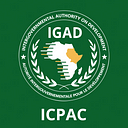Good Biomass Energy Practices to Address Climate Change and Deforestation in the Great Horn of Africa
By Timothy Ranja
With contributions from the ICPAC Climate Change Technical Working Group
Forests are essential for achieving Sustainable Development Goals related to climate change. Bioenergy production affects the environment at the local and global levels, impacting land and water resources, biodiversity and the global climate. Sustainable biomass energy management will play an important role in in the IGAD region as countries embark on implementing their National Determined Contributions (NDCs) to meet their Paris Agreement targets and national pathways to net zero emissions. Currently, six member countries have already submitted their NDCs to UNFCCC outlining adaptation and mitigation actions to assist them meet their climate change targets.
What is Biomass Energy?
Biomass energy refers to energy derived from the combustion or transformation (into liquid or gaseous fuel) of biomass. The region has a huge potential for biomass energy if used sustainably. The potential in the region varies from high potential areas with vast forests to low-potential desert and semi-desert areas, and depends on natural and artificial regeneration. It is estimated that biomass energy plantations on existing unused, deforested or de-graded land in the sub-Saharan Africa region, coupled with modern conversion technologies, could meet two-fifth of the region’s primary energy demand by the year 2025. Biomass is often referred as a conditionally renewable source of energy. This is because it’s not renewable if exploitation exceeds regeneration.
Planting trees as both an adaptation and mitigation measure has featured prominently in the IGAD’s members states NDCs [1]. South Sudan is embarking on mass tree planting to become carbon neutral. The country in its NDCs plans to plant 100 million trees over ten years, and sequester 45 million tons of CO2 equivalent by 2030. Kenya in its NDCs aims to achieve at least 10% of the land area tree cover. Ethiopia in its NDCs also has an ambitious plan of reforesting 3 million hectares of land by 2030. The country also targets to restore 5 million hectares of land by 2030 and 9 million hectares by 2050.
Biomass Energy Usage
Solid biomass accounts for 10% of primary energy supply globally, while wood fuel accounts for over 80% of primary energy supply in sub-Saharan Africa [2]. In Kenya, biomass accounts for about 69% of the total national primary energy production. Despite marked efforts to shift to other sources of energy such as gas and electricity, a recent survey indicated that wood fuel (charcoal and firewood) is the most commonly used primary cooking fuel, currently being used by 75% of Kenyan households. Similarly, 93.2% of rural households use wood fuel (fuelwood or charcoal) as their primary fuel [3]. In Ethiopia biomass energy accounts for 91% of final energy consumption and 98% of energy consumption in the residential sectors.
Biomass is used in the household and industrial (large scale biomass applications) sectors as well as in electricity generation. Biomass energy is an important fuel for many small-scale and medium-scale industries in the region such as brick making, lime production, fish smoking, tobacco curing, beer brewing, including coffee and tea drying.
Small Scale Biomass Energy Technologies
This article focuses on small scale biomass energy technologies. The small scale biomass technologies encompass a wide range, including charcoal production, improved stoves, briquetting and household biogas. Most of the charcoal produced in the region is made by small producers in simple earth kilns near where the trees are felled. It has been estimated that there is a substantial loss of useful energy in converting wood to charcoal and that yield from traditional kilns is 8–15% of the wood consumed. In the last three decades, substantial efforts have been directed towards the modernization of fuelwood production and end-use technologies. Energy efficient kilns and environmentally sound, improved cookstoves for households are now available in the region. Improved cookstoves also play a role in reducing indoor air pollution from smoke that is responsible for most pulmonary diseases [4]. Sudan in its updated first NDCs interim submission in May 2021, targets to replace wood stove in 20% of the rural population by 2030.
Way forward
Despite the technological breakthroughs, promotion of bioenergy in the region is still disappointing and faces several challenges. There is lack of data on the quantity, quality and potential of bioenergy sources and technologies. Information and statistical data on resources, production, trade and consumption of biomass for energy purposes is still weak. Poor institutional structures have resulted in overlap of mandate, roles and functions of organizations in the sector and lack of standards for appropriate technologies. There is no forestry and energy cross-sectoral approaches to promote the integration and diversification opportunities of bioenergy activities. In addition, there is insufficient support to the private sector, forest owners and farmers in bio-fuel production.
For the IGAD member states to meet their NDCs priorities and actions related to bioenergy, a multi-stakeholder approach needs to be adopted and embedded in the NDC implementation plans — this could include national and sub-national policy makers, research institutions, forest resource users and communities, private sector and development partners among others.
Most of the IGAD member states NDCs and low carbon development strategies have for instance indicated they plan to leverage on initiatives such as the REDD+ [5] and the Forest Carbon Partnership Facility that focus on implementing initiatives for conserving forest cover and reducing emissions from deforestation. African countries can use Regional Economic Communities (RECs) such as IGAD to pool their resources towards such efforts.
[1] Forest also act as carbon sinks for greenhouse gases. Trees sequester carbon by capturing carbon dioxide from the atmosphere and transferring it into biomass through photosynthesis.
[2] IEA Statistics (www.iea.org/stats)
[4] According to WHO indoor air pollution globally kills 4 million people every year
[5] Reducing Emissions from Deforestation and Forest Degradation (REDD+) is a United Nations framework that aims to curb climate change by stopping the destruction of forests
